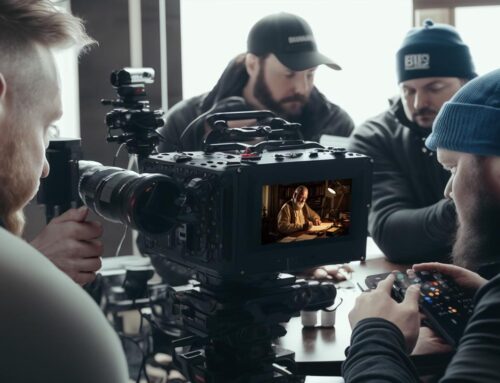In the digital age, the ability to tell a compelling story is more important than ever. With the rise of social media and the explosion of online content, consumers are bombarded with messages every day. Cutting through this noise and truly engaging with an audience requires a unique approach. One method that has proven to be extremely effective is video marketing. This comprehensive guide aims to provide valuable insights into leveraging video marketing to captivate your audience and drive engagement.
In this article, you will learn about the power of video marketing, how it can be harnessed to tell a compelling story, and how this can drive consumer engagement. We will delve into the importance of video production and promotion, and provide practical tips for getting started. Whether you are a marketing professional, a small business owner, or simply someone interested in digital marketing, this guide will equip you with the knowledge you need to leverage video as a powerful tool in your marketing arsenal.
This guide is broken down into digestible sections, each focusing on a key aspect of video marketing. We will start by exploring the importance of visual storytelling and why it is so effective. We will then discuss the key elements of a successful video marketing campaign, including planning, production, and promotion. Finally, we will offer practical tips for creating engaging videos and strategies for promoting them effectively.
By the end of this guide, you should have a solid understanding of how to create and promote engaging video content that resonates with your audience and drives engagement. Moreover, you will learn how to weave compelling narratives into your videos that captivate your audience and make your brand unforgettable.
Table of Contents
- The Power of Video Marketing
- Visual Storytelling: Why it Works
- Planning Your Video Marketing Campaign
- Video Production: Key Elements to Consider
- Promoting Your Video Content
- Practical Tips for Creating Engaging Videos
- Final Thoughts
The Power of Video Marketing
Video marketing is a powerful tool for businesses of all sizes to connect with their customers and drive engagement. Consumers today are increasingly turning to video content over text-based content, making video an essential component of any successful marketing strategy. Let’s look at some of the reasons why video marketing is so effective.
Growing Consumer Preference for Video
Recent studies show that consumers prefer video content to other forms of content. According to a report by HubSpot, 54% of consumers want to see more video content from brands or businesses they support .
Increased Engagement
Video content generates higher engagement rates compared to other forms of content. Videos are shared 12 times more than text and images combined on social media. This not only increases your brand’s visibility but also fosters a sense of community among your audience.
Improved Understanding of Products and Services
Videos can explain your product or way that text or images simply can’t match. They allow you to demonstrate how your product works, what services you offer, and why they are beneficial. According to Wyzowl, 94% of marketers say video has helped increase user understanding of their product or service .
Boosts Conversion Rates
Video content can also significantly boost conversion rates on landing pages. A study by EyeView Digital found that using video on landing pages can increase conversions by up to 80% .
Enhanced SEO
Search engines love video because it keeps visitors on your site for longer. This longer exposure signals search engines that your site has good content. According to Moovly, you’re 53 times more likely to show up on Google’s first page if you have a video embedded on your website.
Visual Storytelling: Why it Works
Visual storytelling involves using graphics, images, and videos to convey a message or tell a story. This form of storytelling can be a powerful tool for capturing your audience’s attention and driving engagement. Here’s why visual storytelling is so effective.
Grabs Attention
In a world where attention spans are decreasing, visual content like videos are key to grabbing and holding your audience’s attention. Visual content is processed much faster by the human brain compared to text, making it a potent tool for capturing attention.
Easier to Understand
Visual content can simplify complex concepts, making them easier for your audience to understand. This is particularly beneficial when explaining complex products or services.
Emotional Connection
Visual storytelling allows you to create an emotional connection with your audience. By incorporating elements like music, voice, and facial expressions, you can evoke a wide range of emotions, making your content more relatable and memorable.
Drives Action
Because of the emotional connection that visual storytelling can create, it’s more likely to drive action. Whether it’s sharing your content, visiting your website, or making a purchase, visually engaging content can inspire your audience to take the desired action.
Planning Your Video Marketing Campaign
Before you start creating videos, it’s important to have a clear plan in place. This includes understanding your audience, setting clear goals, and determining how you will measure success. Here are some key steps in planning your video marketing campaign.
Understand Your Audience
The first step in planning your video marketing campaign is to understand your audience. What are their interests? What problems are they trying to solve? What type of content do they engage with?
Set Clear Goals
What do you hope to achieve with your video marketing campaign? Are you trying to increase brand awareness, boost sales, or drive website traffic? Having clear goals will guide your video creation process and help you measure success.
Determine Your Video Type
There are many types of videos you can create, including explainer videos, how-to videos, testimonial videos, product demos, and more. The type of video you choose will depend on your goals and your audience’s preferences.
Plan Your Content
Once you’ve determined the type of video you’ll create, it’s time to plan your content. What story will you tell? How will you convey your message in a way that engages your audience?
Decide on Distribution Channels
Where will you share your video content? Will it be on your website, social media platforms, or email marketing campaigns? The channels you choose will depend on where your audience spends their time.
Measure Success
Finally, determine how you will measure the success of your video marketing campaign. This might include metrics like video views, shares, likes, comments, or conversions.
Video Production: Key Elements to Consider
Creating engaging video content requires careful consideration of several key elements. Here’s what you need to know.
Storytelling
The most engaging videos tell a story. Whether it’s a customer success story, the journey of your company, or how your product came to be, find a story that resonates with your audience and use it to frame your video.
Quality
High-quality videos reflect well on your brand. This doesn’t mean you need to invest in expensive equipment, but your video should be clear, well-lit, and easy to hear. Consider hiring a professional videographer or using a high-quality camera and microphone.
Length
Video length matters. Today’s consumers have short attention spans, so keep your videos concise and engaging. According to HubSpot, the optimal video length depends on the platform: Instagram: 30 seconds, Twitter: 45 seconds, Facebook: 1 minute, and YouTube: 2 minutes .
Call to Action
What action do you want viewers to take after watching your video? Whether it’s visiting your website, sharing your video, or making a purchase, make sure to include a clear and compelling call to action.
Promoting Your Video Content
Creating a great video is just the first step. You also need to promote your video to reach your audience. Here are some strategies for promoting your video content.
Social Media
Social media platforms like Facebook, Instagram, and LinkedIn are excellent channels for promoting your video content. Post your video directly on these platforms to reach your followers and consider investing in social media advertising to reach a wider audience.
Email Marketing
Including videos in your emails can increase click-through rates and engagement. Consider sending your video in a dedicated email or including it in your regular newsletters.
Your Website
Your website is an excellent place to showcase your video content. Consider adding videos to your homepage, product pages, or blog to engage visitors.
YouTube
YouTube is the second largest search engine after Google, making it a powerful platform for video promotion. Optimize your video’s title, description, and tags to help it get discovered.
Collaborations
Collaborating with influencers or other businesses in your industry can help your video reach a larger audience. Consider partnering for a video project or asking others to share your video with their followers.
Practical Tips for Creating Engaging Videos
Creating engaging videos doesn’t have to be difficult. Here are some practical tips to help you create video content that resonates with your audience.
Keep it Simple
Your video should convey a clear, concise message. Avoid jargon and complicated concepts. Instead, focus on telling a simple, compelling story.
Make it Visually Appealing
Use high-quality images, animations, and graphics to make your video visually appealing. This can help grab your viewer’s attention and keep them engaged.
Use Emotion
Emotion is a powerful tool in video marketing. Whether it’s humor, excitement, or empathy, evoke emotion to make your video more engaging and memorable.
Include Captions
Many people watch videos without sound, especially on social media. Including captions ensures your message is understood, even without sound.
Test and Learn
Finally, remember that video marketing is a learning process. Test different types of videos, monitor your results, and adjust your strategy based on what works best with your audience.
Final Thoughts
The most important takeaway from this article is the power and potential of video marketing. In an age of content saturation, standing out from the crowd is crucial, and video provides an engaging and versatile medium to do just that. By mastering visual storytelling and understanding the key elements of successful video production and promotion, you can craft compelling narratives that truly resonate with your audience.
Remember, the ultimate goal is not just to create content but to tell a story that will captivate your audience and make your brand unforgettable. The power of video marketing lies in its ability to combine visuals, sound, and narrative in a way that no other medium can. By leveraging this power, you can create a meaningful connection with your audience and inspire them to take action.
Keep in mind that video marketing is not a one-size-fits-all solution. What works for one business may not work for another. Therefore, it’s crucial to understand your audience, continually test and refine your approach, and stay abreast of the latest trends and best practices in video marketing.
The journey to successful video marketing may require time and effort, but the potential rewards — increased brand awareness, stronger customer relationships, and boosted sales — make it well worth the investment.













